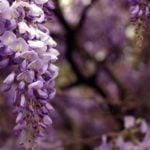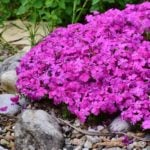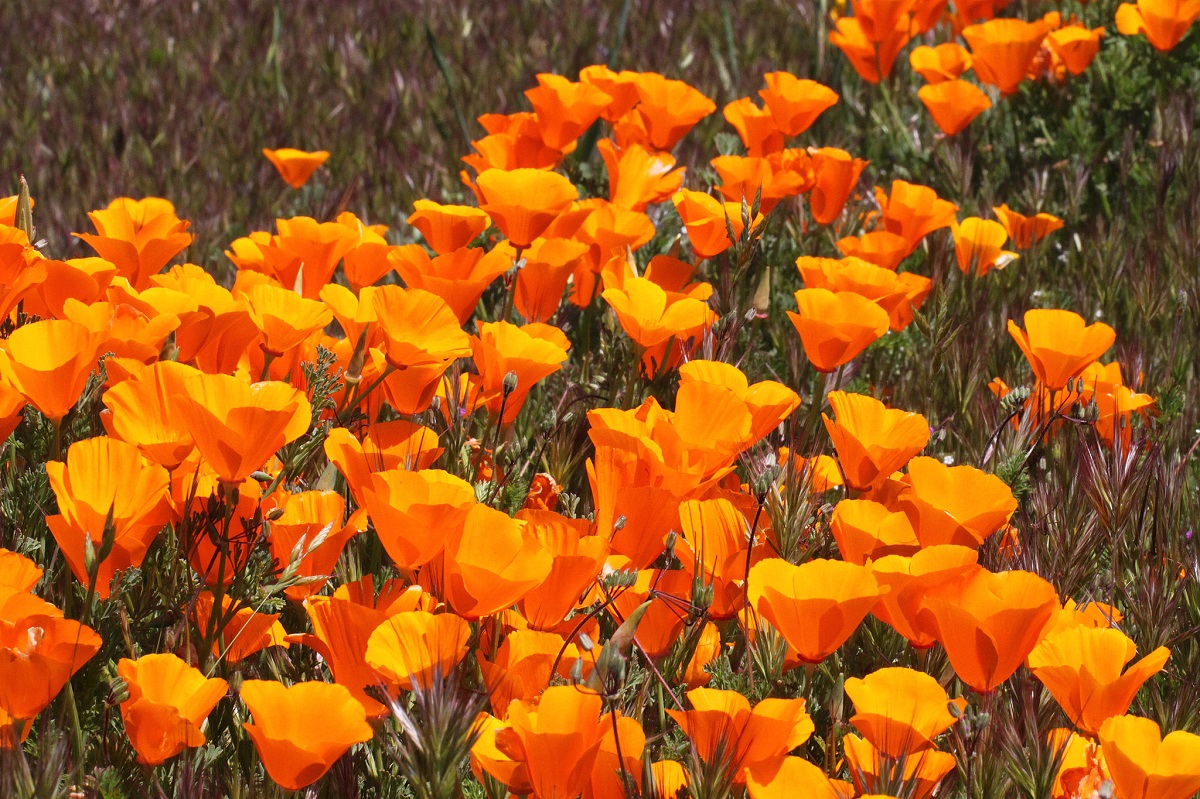
With extended droughts, wildfires, and extreme heat, choosing landscape plants in California can be a challenge. When you use native California plants, you can be sure they’ll survive your local climate and even help you save water. If you’re just getting started on your native garden, here are 32 of the best native plants for California landscapes.
These, along with California’s hundreds of other native plants, can make your landscaping look great while helping to preserve the local ecosystem. Native plants also benefit local wildlife such as bees, butterflies, and birds. Let’s get started!
- Native California Flowers / Succulents
- Beardtongue (Penstemon)
- Blue-Eyed Grass (Sisyrinchium bellum)
- California Cholla (Cylindropuntia californica)
- California Fuchsia (Epilobium canum)
- California Milkweed (Asclepias californica)
- California Poppy (Eschscholzia californica)
- Coastal Prickly Pear (Opuntia littoralis)
- Common Yarrow (Achillea millefolium)
- Coulter’s Matilija Poppy (Romneya coulteri)
- Douglas Iris (Iris douglasiana)
- Island Alum Root (Heuchera maxima)
- Live-Forever (Dudleya)
- Mountain Violet (Viola purpurea)
- Sage (Salvia)
- Native California Shrubs / Trees
- Buckwheat (Eriogonum)
- Bush Anemone (Carpenteria californica)
- Bush Monkey Flower (Mimulus aurantiacus)
- Bush Sunflower (Encelia californica)
- California Gooseberry (Ribes californicum)
- California Lilac (Ceanothus)
- California Sagebrush (Artemisia californica)
- Catalina Currant (Ribes viburnifolium)
- Chaparral Mallow (Malacothamnus fasciculatus)
- Coffeeberry (Frangula californica)
- Deergrass (Muhlenbergia rigens)
- Flannel Bush (Fremontodendron californicum)
- Giant Wildrye (Leymus condensatus)
- Lemonade Berry (Rhus integrifolia)
- Manzanita (Arctostaphylos)
- Silver Lupine (Lupinus albifrons)
- Toyon (Heteromeles arbutifolia)
- Western Redbud (Cercis occidentalis)
- FAQ
Native California Flowers / Succulents
Beardtongue (Penstemon)
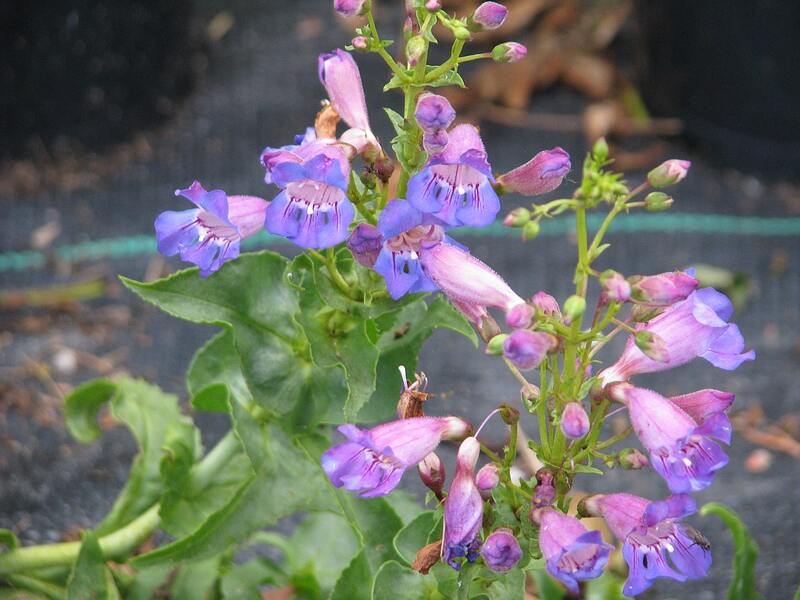
California has many native species of beardtongue flowers, which bloom in early spring with spectacular flowers that vary in color depending on the species. One of the most popular among native gardeners is the accurately named showy penstemon (Penstemon spectabilis) (pictured).
Hardiness zones: 3a-9b depending on species
Sun: Full sun
Soil: Well-draining sandy or rocky soils
Duration: Perennial
Height: 6 inches to 4 feet depending on species
Maintenance: Water 1 inch per week in summer, cut back stems after flowering season
Note: These native California flowers are full-sun plants. California homeowners can use them in garden beds without the shade of trees.
Blue-Eyed Grass (Sisyrinchium bellum)
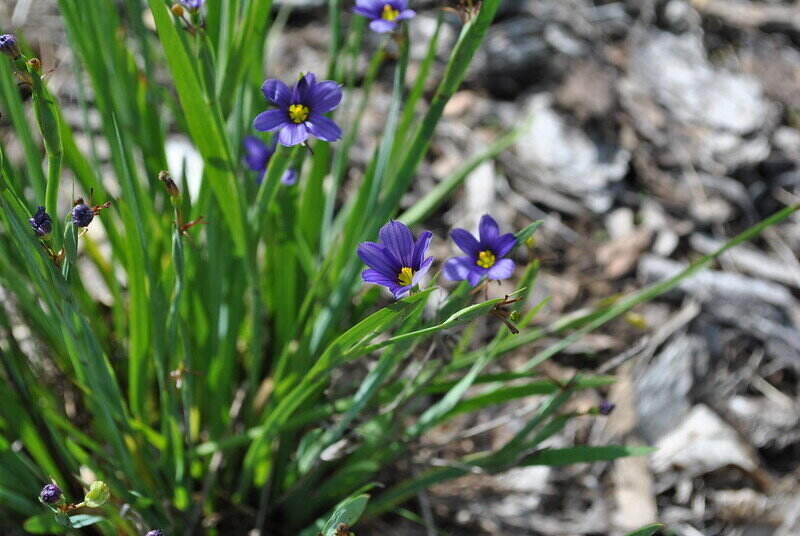
Blue-eyed grass gets its common name from its grassy leaves and small blue or purple flowers that bloom from late winter through spring. This fire-resistant, easy-to-grow flower is a perfect colorful addition to California flower gardens.
Hardiness zones: 4a-9b
Sun: Full sun, partial shade
Soil: Moist loam soils
Duration: Perennial
Height: 1 to 2 feet
Maintenance: Water occasionally during summer droughts
California Cholla (Cylindropuntia californica)
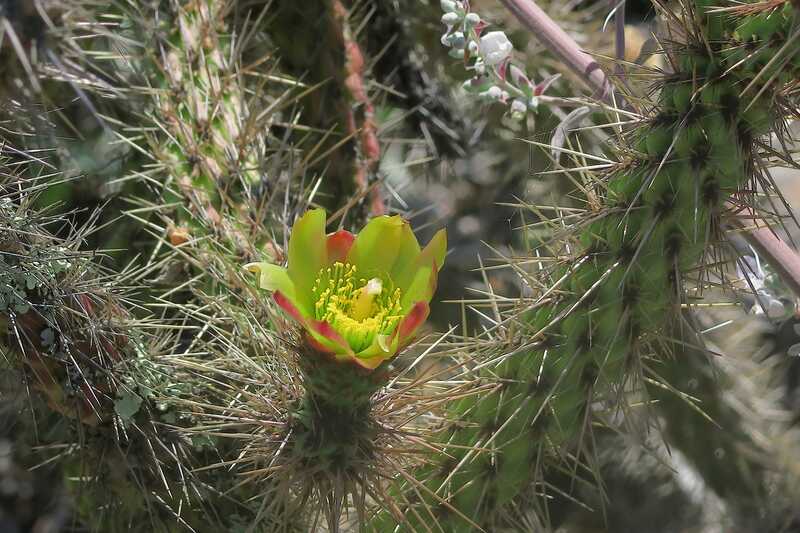
California cholla, aka snake cholla, aka cane cholla, grows in long snakelike cylinders that can both get very tall and sprawl to cover a lot of ground. The California cholla is a cactus, of course, so it has spines that aren’t friendly for high-traffic areas, but it also has pretty yellow or green flowers with purplish red accents that could look great in your landscaping.
Hardiness zones: 8a-10b
Sun: Full sun
Soil: Any dry, fast-draining soil
Duration: Perennial
Height: Up to 10 feet
Maintenance: Make sure roots don’t get too damp, otherwise they’ll rot.
California Fuchsia (Epilobium canum)
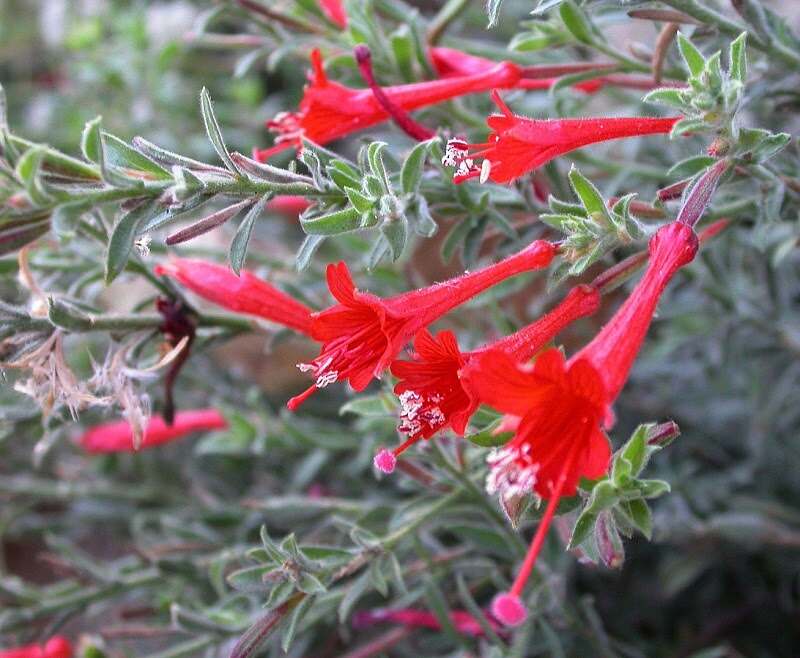
The California fuchsia is a species of willowherb with bright red, thin flowers that somewhat resemble the flowers of a true fuchsia plant (thus the common name). It’s sometimes called the hummingbird flower because its flowers, which bloom in summer and fall, are extremely attractive to hummingbirds.
Hardiness zones: 8a-10b
Sun: Full sun
Soil: Any well-draining soil
Duration: Perennial
Height: 3 to 18 inches
Maintenance: Cut back to the ground after flowering season to promote healthy new growth, water once a month during summer in dry inland areas.
California Milkweed (Asclepias californica)
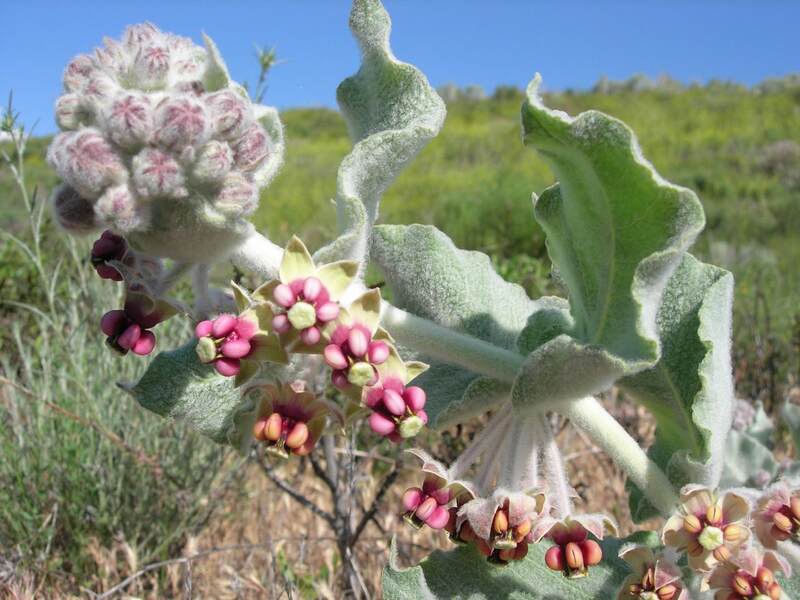
The California milkweed is just one of the state’s native milkweed species, most of which host monarchs and other butterflies. California milkweeds have thick, white, hairy stems that can add an interesting element to any flower garden, and they bloom in spring and summer with round clusters of tiny flowers that range in color from white to bright pink or lavender.
Hardiness zones: 7a-10b
Sun: Full sun
Soil: Sandy or clay soils
Duration: Perennial
Height: Up to 3 feet
Maintenance: Avoid using pesticides on or near milkweeds because they’re important wildlife plants.
California Poppy (Eschscholzia californica)
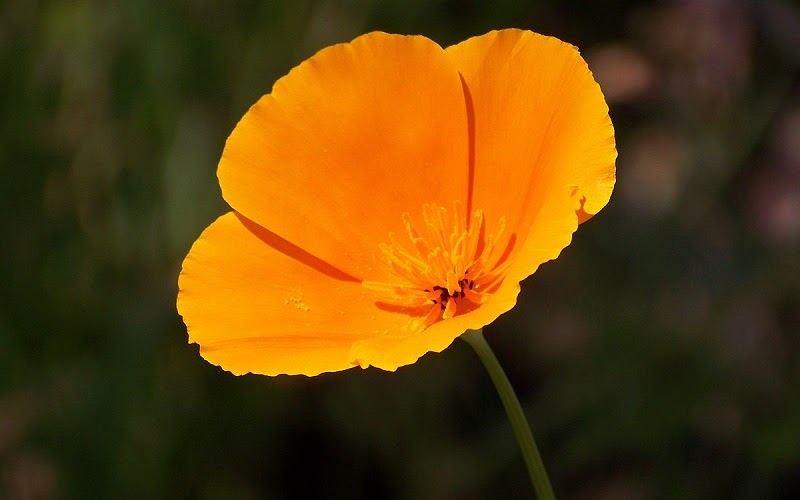
The vibrant orange California poppy, California’s state flower, is drought-tolerant, easy to grow, and often reseeds itself. Poppies bloom in spring, and in cooler parts of the state, the flowers can last all the way through the summer.
Hardiness zones: 5a-10b
Sun: Full sun
Soil: Well-draining sandy soils
Duration: Perennial in mild-winter regions, annual in areas with cold winters Height: 4 to 12 inches
Maintenance: Water occasionally during exceptionally dry growing seasons and cut them back to keep them contained as they spread readily. The California poppy is one of the most popular flowers grown in California because it’s tough and can withstand dry conditions.
Coastal Prickly Pear (Opuntia littoralis)
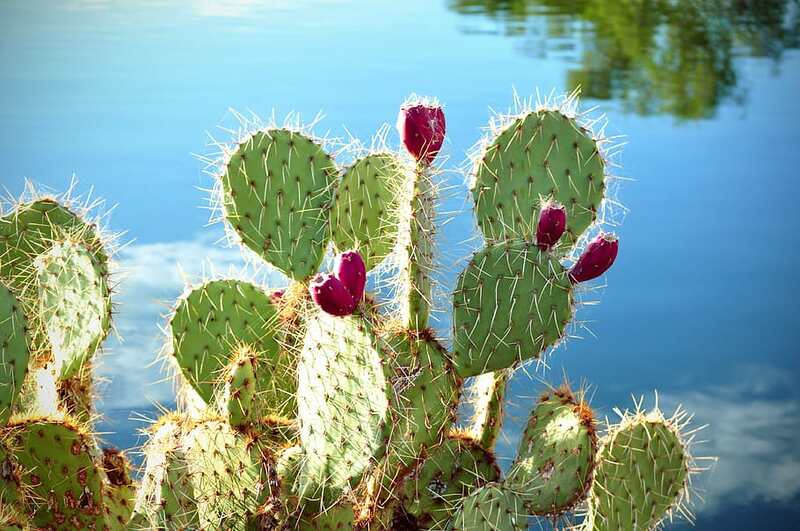
The coastal prickly pear is a species of cactus that varies in appearance but generally grows in tall, spreading clumps of flat oval-shaped branches, with bright red or yellow flowers and purplish fruits. Because the coastal prickly pear is a succulent, it doesn’t need a lot of water and is perfect for water-wise gardens — just be careful of the sharp spines.
Hardiness zones: 9b-11b
Sun: Full sun
Soil: Sandy soils
Duration: Perennial
Height: 1 to 2 feet
Maintenance: Make sure roots don’t get too damp, otherwise they’ll rot.
Common Yarrow (Achillea millefolium)
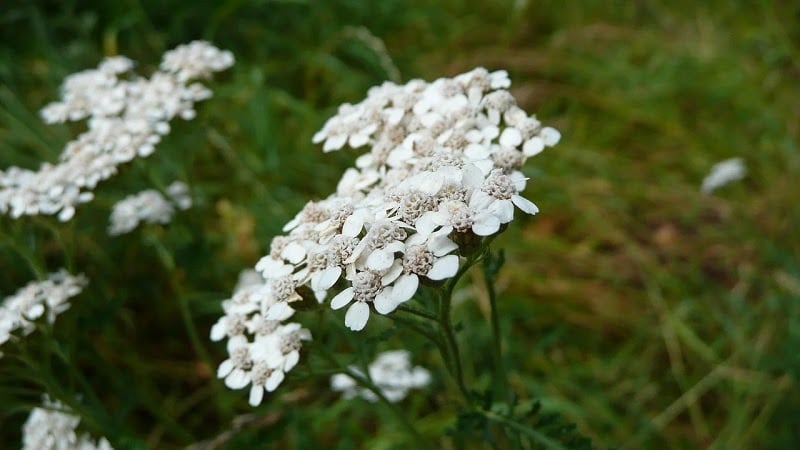
Yarrow has many common names, including nosebleed plant, old man’s pepper, devil’s nettle, and thousand-leaf. These California native flowers are often included in butterfly gardens due to their fragrant clusters of tiny white flowers that bloom during spring and summer.
Hardiness zones: 3a-9b
Sun: Full sun, partial shade, full shade
Soil: Tolerates most soil types
Duration: Perennial
Height: 1 to 3 feet
Maintenance: Cut off dead flowers to encourage more blooms, treat common problems like aphids, mildew, and stem rot as needed.
Coulter’s Matilija Poppy (Romneya coulteri)
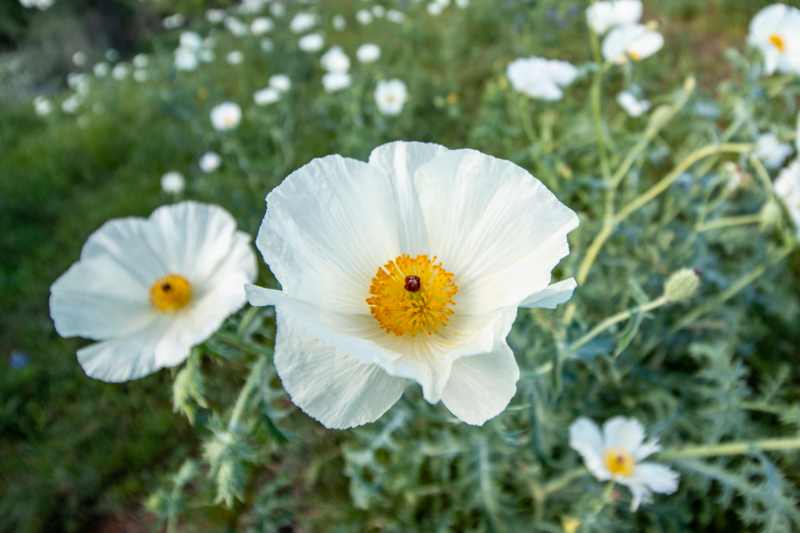
Coulter’s Matilija poppy is native to dry chaparral and coastal sage scrub plant communities in Southern California, and it can sometimes grow in recently burned areas. The large, showy white flowers with bright yellow centers bloom in spring and summer, and the plant can spread aggressively if left unchecked.
Hardiness zones: 7a-11b
Sun: Full sun
Soil: Fast-draining sandy or gravelly soils
Duration: Perennial
Height: 6 to 10 feet
Maintenance: Cut down in late summer or fall to encourage new growth, pull shoots to prevent unwanted spreading.
Douglas Iris (Iris douglasiana)
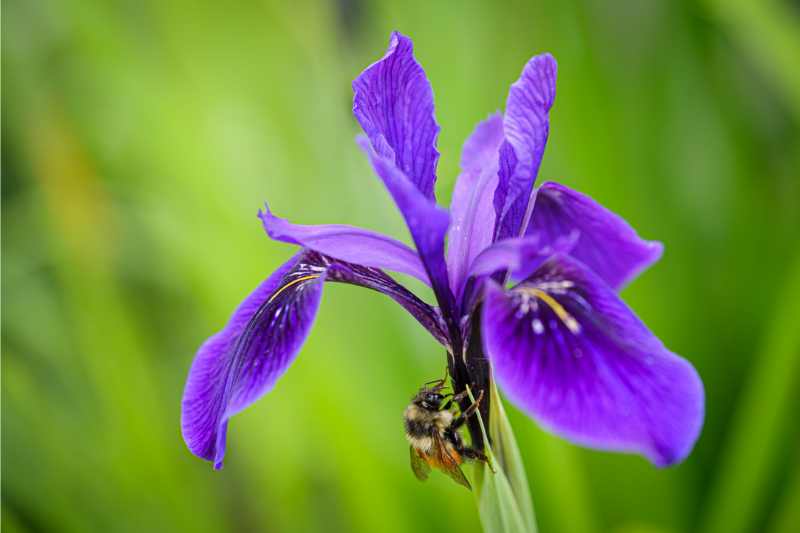
This wildflower has many cultivars in coastal Northern and Central California, with spring blooms in blue, purple, pink, white, or yellow. Some varieties grow in clumps and work well as a colorful groundcover in landscapes.
Hardiness zones: 7a-9b
Sun: Full sun, partial shade, full shade
Soil: Rich, moist soils
Duration: Perennial
Height: Up to 2.6 feet
Maintenance: Water every two to four weeks during summer in dry areas.
Island Alum Root (Heuchera maxima)
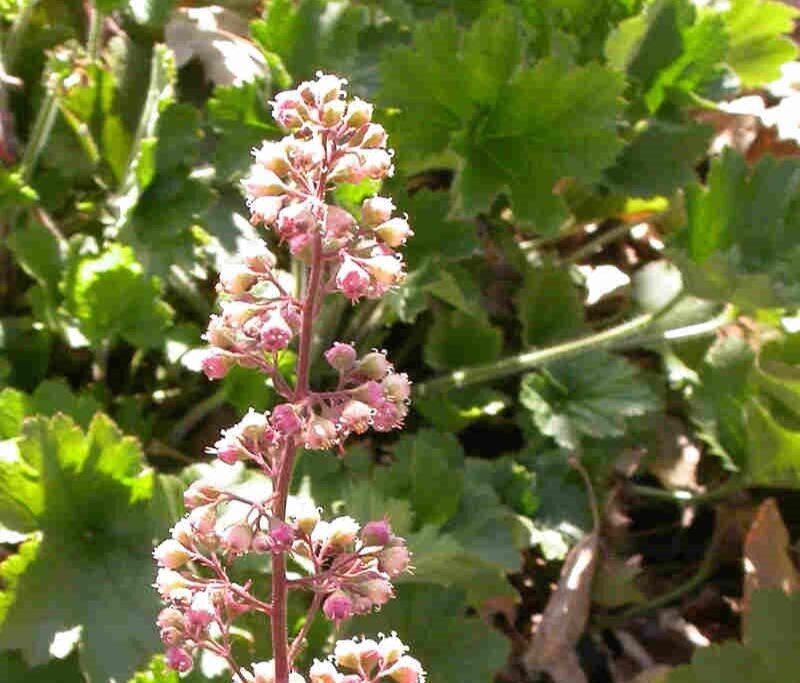
Island alum root, aka Jill-of-the-rocks, is native only to the Channel Islands off California’s coast, but it thrives in many gardens on the mainland, where it does best in coastal areas but can grow inland as well. Its tiny, round, bright pink flowers bloom in upright clusters that hummingbirds love to snack on.
Hardiness zones: 8b-11b
Sun: Full sun, partial shade, full shade
Soil: Well-draining sandy or rocky soils
Duration: Perennial
Height: 1 to 2 feet
Maintenance: May need to water regularly depending on location.
Live-Forever (Dudleya)
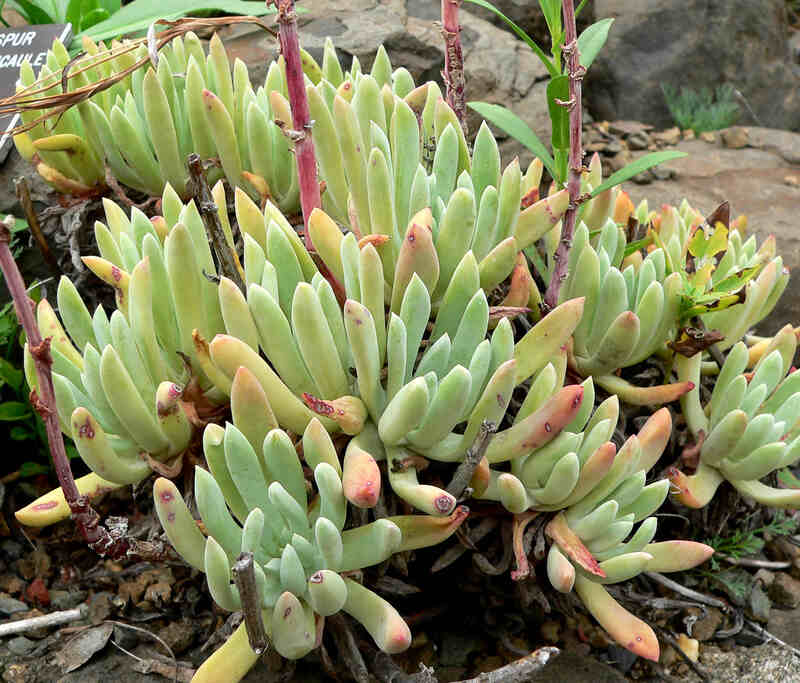
California is home to 40+ native species of Dudleya succulents, many of which are referred to as “live-forevers” because they last for up to 100 years in the wild. There are branching and non-branching varieties, most of which have green or silvery-white leaves and sprout flowers in late winter or early spring.
Hardiness zones: 6a-11b
Sun: Full sun on the coast, afternoon shade in inland areas
Soil: Fast-draining soils
Duration: Perennial
Height: 1 to 2 feet
Maintenance: Treat for pests attracted to this plant, including aphids, mealybugs, gnats, slugs, and snails.
Mountain Violet (Viola purpurea)
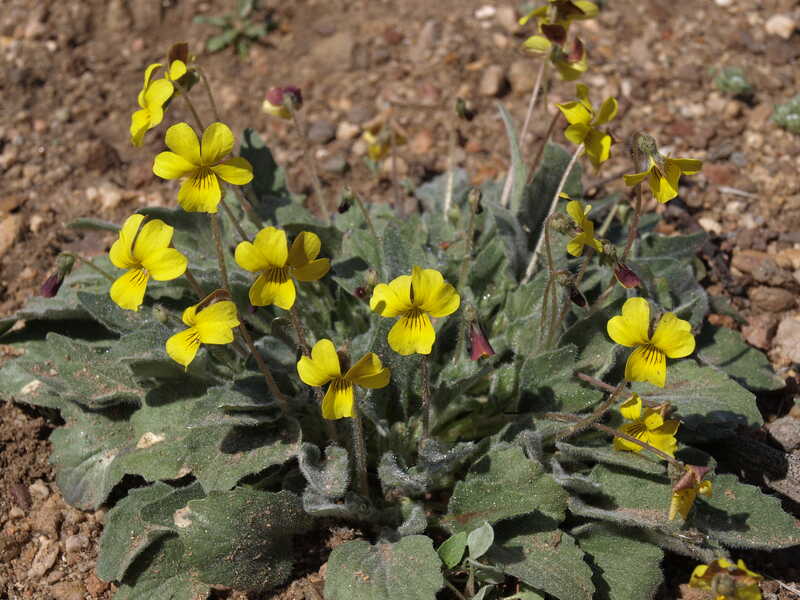
The mountain violet, aka goosefoot violet, has a deceitful scientific name, since its flowers are neither violet nor purple but bright yellow. Many subspecies and cultivars of this wildflower are available throughout California, and they’re great for adding a golden touch to your landscape or flower garden in spring.
Hardiness zones: 6b-9b
Sun: Full sun, partial shade
Soil: Silt or sandy soils
Duration: Perennial
Height: Half inch to 4 inches
Maintenance: Remove dead flowers to encourage more blooms.
Sage (Salvia)
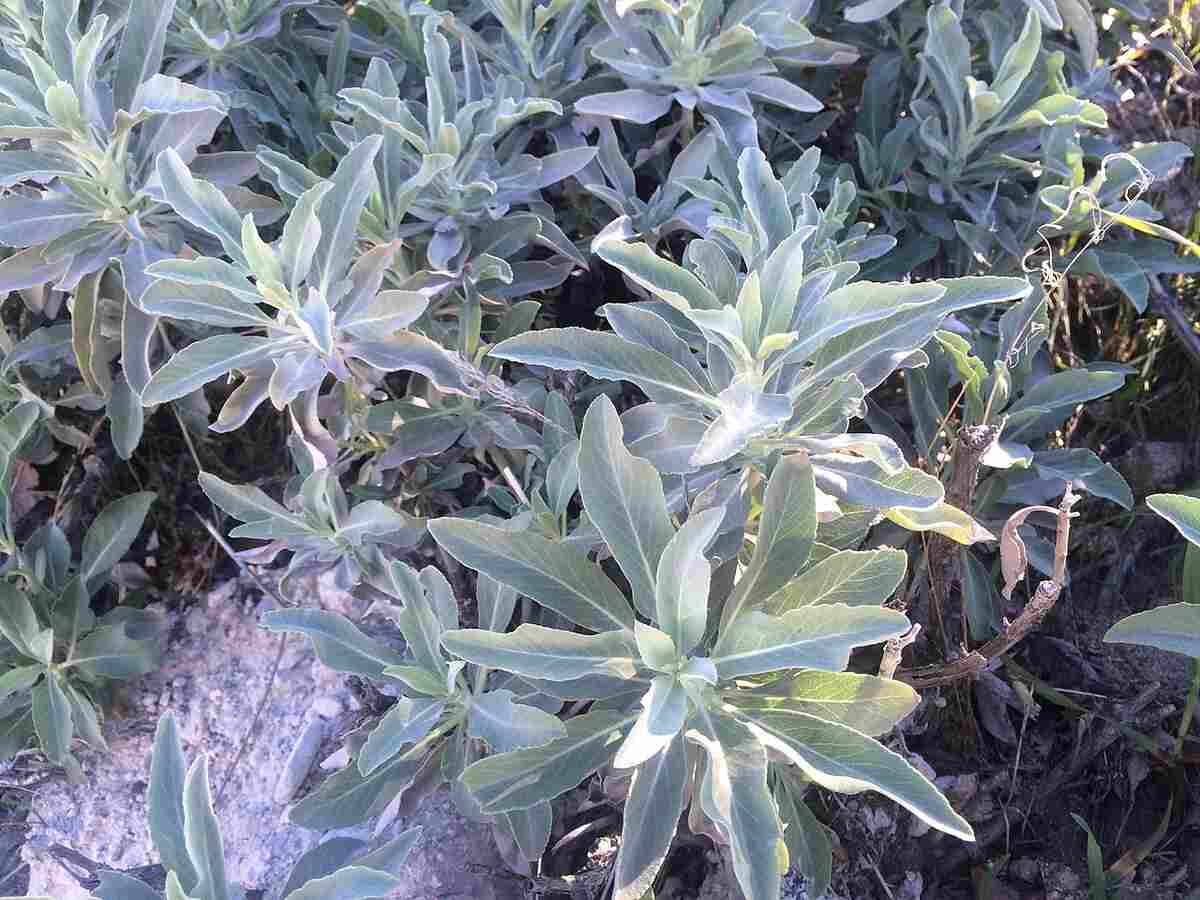
California has 18 native sage species that thrive in different parts of the state, some of which are white sage (pictured), musk sage, and desert sage. Sage’s flowers, which bloom in summer, come in many different colors depending on the species, and hummingbirds love them so much that one native is actually called hummingbird sage (Salvia spathacea).
Hardiness zones: 3a-11b depending on species
Sun: Full sun, partial shade
Soil: Any well-draining soil
Duration: Perennial or annual depending on species and location
Height: 1 foot to over 4 feet, depending on species
Maintenance: Prune lightly in spring, remove dead flowers to encourage more blooms.
Ask The Experts
For more detail about the best California native plants, we went to a Golden State educator expert. Here are the questions we posed, and you’ll find his answers below:
- How can using native plants in landscaping benefit California’s wider environment?
- What are the best California natives to plant during a drought? Why these?
- What negative effects do invasive non-native plants have on the local environment?
- What native plants are easiest to grow in Southern California, and which are easiest to grow in Northern California?


How can using native plants in landscaping benefit California’s wider environment?
Simply put, incorporating native plants into residential and commercial landscaping builds habitat for birds, pollinators, lizards, bugs, etc. Additionally, using native plants will significantly reduce irrigation requirements and fertilizer and pesticide use.
What are the best California natives to plant during a drought? Why these?
The natives we have had success with at Chico State are California fucshia, bearded penstemon, milkweed, salvia (including native hybrids), oaks, manzanita, redbuds, dogwoods, deer grass, pink muhly, Matilija poppy, California poppy, sedges, Oregon grape, ferns, along with numerous others. We have chosen these plants due to their durability, ease of establishment, varied textures, attractive blooms or seed heads, and the ability to complement our existing landscape areas.
What negative effects do invasive non-native plants have on the local environment?
Ornamental plants require more water and are much more susceptible to insect damage and disease. Managing pests (including weeds) and disease in ornamentals requires more labor and typically includes some form of herbicide or pesticide use. Plus, ornamentals typically need to be on a fertilizer program. Add to this the need to shape hedges, edge and mow lawns, and cultivate seasonal planter beds, and gas-powered equipment comes into play.
If done correctly with calibrated equipment, pesticides, herbicides, and fertilizer applications can have a very low environmental impact. However, residential use of these products by the untrained community and untrained landscape maintenance workers can easily lead to excessive use and subsequent runoff into waterways. The adverse effects worsen if the irrigation habits of nonprofessionals lead to excessive water consumption, which creates even more runoff.
When the incorrect application of chemicals is combined with excessive irrigation, waterways get polluted, soil conditions deteriorate, and plants become weakened. Weak plants then look like they need more food or water, and the vicious cycle gets worse — lawns grow quick and thick, requiring more mowing, which adds exhaust to the air.
My hope is that, with newer irrigation controls hitting the market and better training for landscape workers, some of these problems will improve. With good information so easily accessible by the general public, I hope the homeowner behaviors improve, too. As for information, I have been referring more and more people to reach out to their local ag extension offices and master gardener programs.
What native plants are easiest to grow in Southern California, and which are easiest to grow in Northern California?
More specifically, it is important to understand which “zone” a person lives in when selecting plants. From there, it is equally important to understand what microclimates exist at the landscape site.
For example, my home has two vastly different climates. The front yard gets scorched by the sun year-round, while the back yard is shady and is noticeably cooler by several degrees. This means plants that do well in the backyard will struggle to survive in the front.
When selecting plants, it is imperative to know the site and its nuances. Once this information is gathered, then plant selection can begin. I suggest talking to the technicians at your local nursery to see if their stock will fit your needs and preferences.
Which are the best native plants for homes on the coast, and which are best for homes in the mountains?
More specifically, it is important to understand which “zone” a person lives in when selecting plants. From there, it is equally important to understand what microclimates exist at the landscape site.
For example, my home has two vastly different climates. The front yard gets scorched by the sun year-round, while the back yard is shady and is noticeably cooler by several degrees. This means plants that do well in the backyard will struggle to survive in the front.
When selecting plants, it is imperative to know the site and its nuances. Once this information is gathered, then plant selection can begin. I suggest talking to the technicians at your local nursery to see if their stock will fit your needs and preferences.
Native California Shrubs / Trees
Buckwheat (Eriogonum)
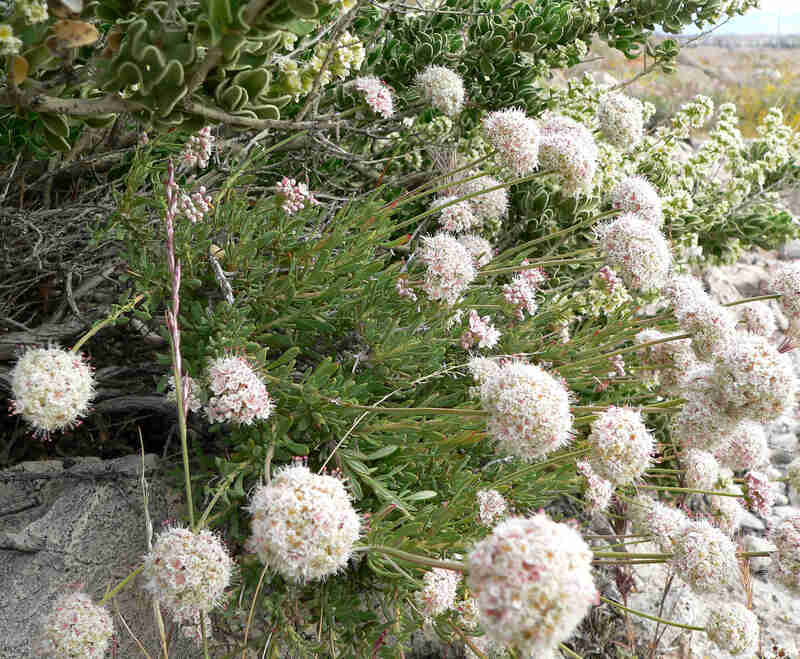
More than 125 species of buckwheat are native to California, including the common California buckwheat (Eriogonum fasciculatum) (pictured). Buckwheat blooms in late spring with rounded clusters of tiny flowers that look like a puff ball from far away, then keeps the flowers until fall, when they fade from white or pink to orange or brown.
Hardiness zones: 7a-11b
Sun: Full sun
Soil: Dry or mostly dry well-draining soils
Duration: Evergreen
Height: 1 to 6 feet
Maintenance: Cut back every few years to encourage healthy new growth and control shape.
Bush Anemone (Carpenteria californica)
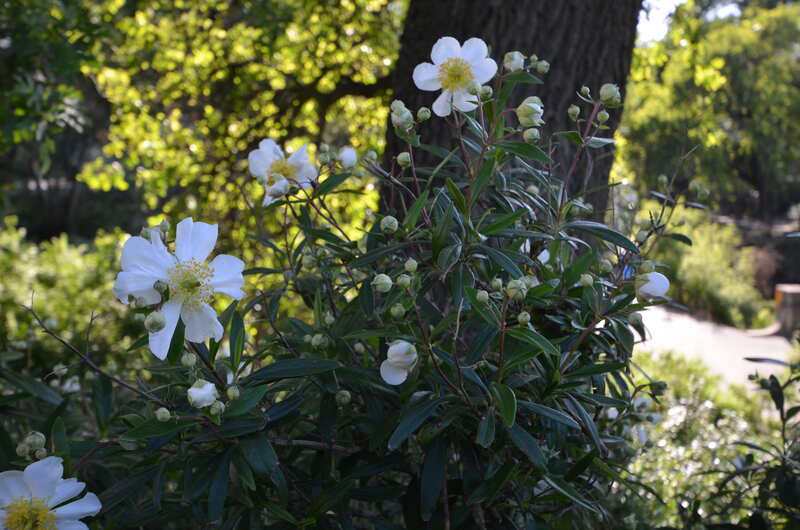
The bush anemone is a rare plant endemic to Fresno and Madera counties (meaning that’s the only place it’s native to). In summer, it produces little white anemone-shaped flowers with bright yellow centers that attract pollinators such as butterflies and bees.
Hardiness zones: 8a-9b
Sun: Full sun, partial shade
Soil: Tolerates most soil types
Duration: Evergreen
Height: 6 to 10 feet
Maintenance: Prune to prevent floppy branches, look out for aphids.
Bush Monkey Flower (Mimulus aurantiacus)
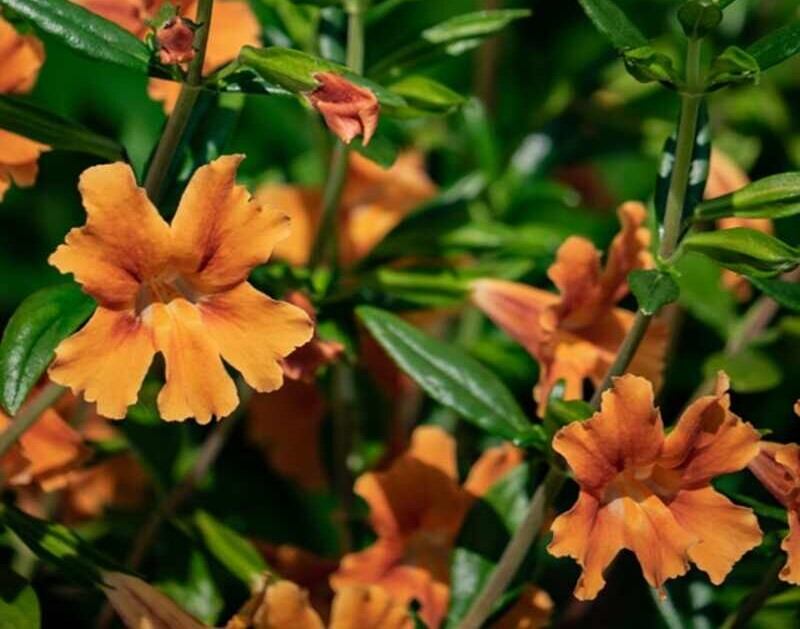
Bush monkey flower has dark green sticky leaves and blooms in winter, spring, and summer with flowers that are usually light orange but can range from white to red. California is home to several cultivars of this shrub of different sizes and colors.
Hardiness zones: 7a-11b
Sun: Full sun, partial shade
Soil: Well-draining clay, loam, or sandy soils
Duration: Evergreen
Height: 3 to 5 feet
Maintenance: Remove dead flowers to encourage more blooms, pinch back new growth in spring if you want the shrub to stay compact.
Bush Sunflower (Encelia californica)
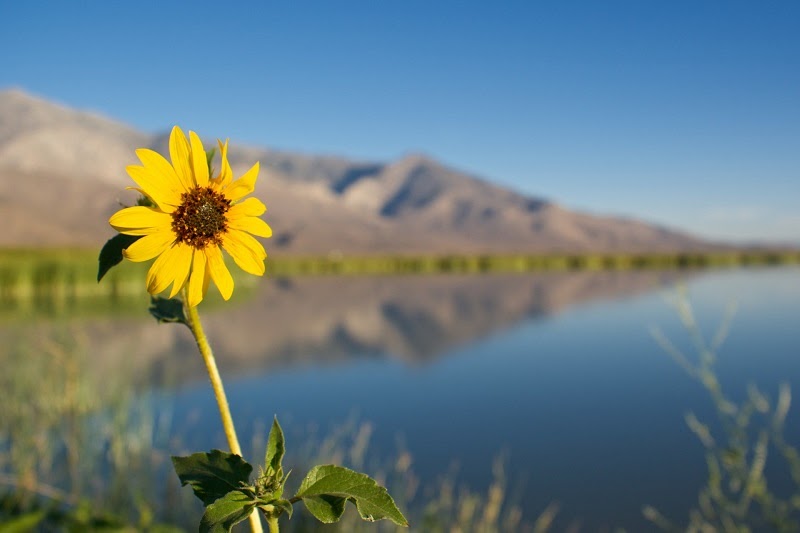
Bush sunflower, aka California brittlebush, is a shrub in the daisy family that produces small yellow daisy-like flowers in late winter and spring. This shrub is easy to grow, so it’s a good addition to the garden, but beware: It grows so quickly that it can become weedy and choke out other plants in your garden if left unchecked.
Hardiness zones: 10a-11b
Sun: Full sun, partial shade
Soil: Tolerates most soil types
Duration: Deciduous
Height: 18 inches to 5 feet
Maintenance: Prune after flowering to encourage healthy and compact new growth.
California Gooseberry (Ribes californicum)
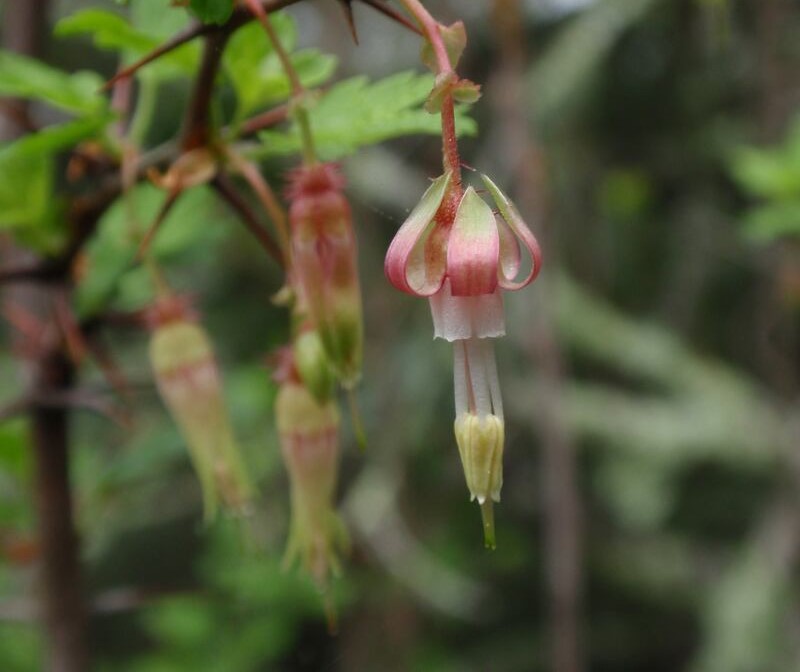
California gooseberry, aka hillside gooseberry, is just one of the state’s many native gooseberry/currant plants. This species grows along the coast from Northern to Southern California and produces small pink, purple, or yellow flowers and fruits that make it valuable for local wildlife such as birds, bees, and butterflies.
Hardiness zones: 6a-9b
Sun: Partial shade
Soil: Moist but well-draining soils
Duration: Deciduous
Height: 3 to 8 feet
Maintenance: Water regularly during growing season, cut off dead limbs.
California Lilac (Ceanothus)
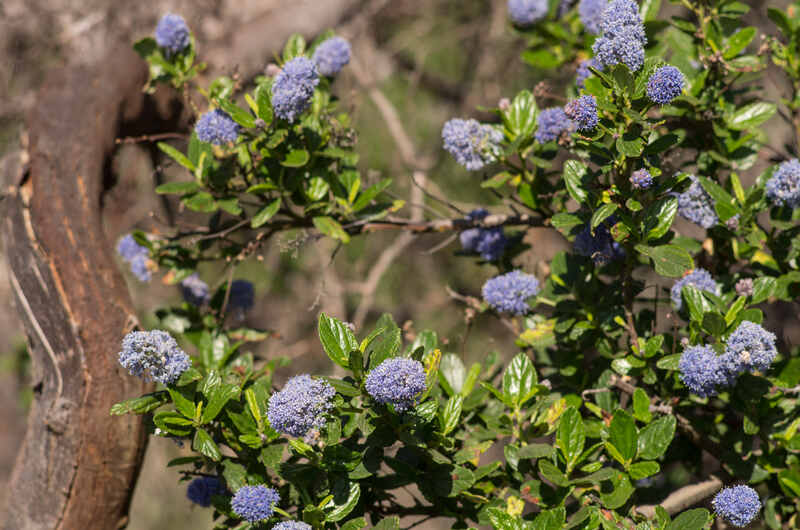
The Ceanothus genus, commonly known as California lilac, wild lilac, mountain lilac, or buck brush, includes more than 60 shrubs in the buckthorn family. These plants have glossy ovate leaves and bloom in spring with clusters of small blue, white, or pink flowers that are fragrant and attractive to butterflies, bees, hummingbirds, and other pollinators.
Hardiness zones: 8a-10b
Sun: Full sun, some afternoon shade in hotter areas
Soil: Fast-draining soils
Duration: Evergreen
Height: 1 to 6 feet
Maintenance: Lightly prune and remove dead limbs as needed.
California Sagebrush (Artemisia californica)
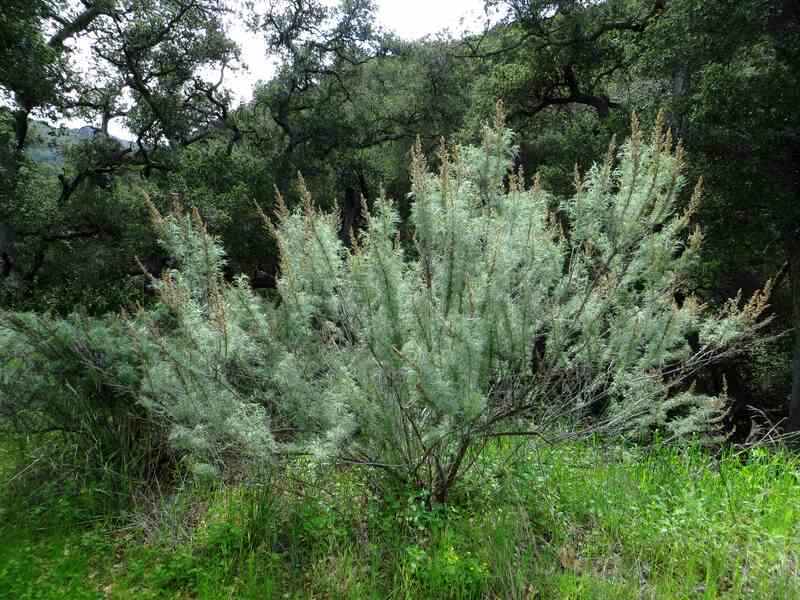
California sagebrush (only one of the state’s native Artemisia species) has small, hairy leaves in light green or gray and sparse flower clusters ranging in color from white to yellow. Drought-tolerant and fast-growing, sagebrush makes a great groundcover, but beware — the plant’s quick spreading can become undesirable and weedy.
Hardiness zones: 7a-9b
Sun: Full sun
Soil: Dry sandy or clay soils
Duration: Deciduous
Height: 1 to 8 feet
Maintenance: Water a maximum of once per month during dry summers.
Catalina Currant (Ribes viburnifolium)
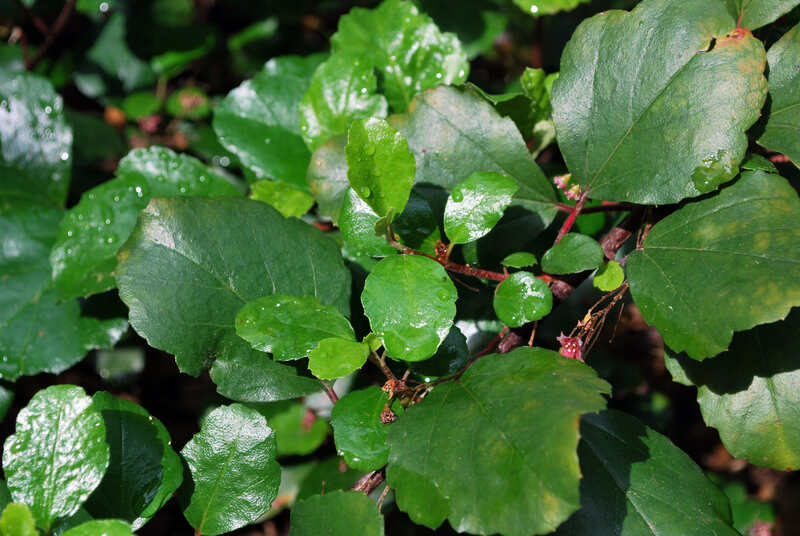
The Catalina currant, aka island gooseberry, aka evergreen currant, is another of California’s native currant plants. It has shiny dark green leaves that produce a pleasantly citrus-scented sap, and it grows small red fruits in late spring that attract birds, including hummingbirds.
Hardiness zones: 6a-10b
Sun: Partial shade
Soil: Tolerates most soils
Duration: Evergreen
Height: 2 to 3 feet
Maintenance: Water once a month maximum during summer.
Chaparral Mallow (Malacothamnus fasciculatus)
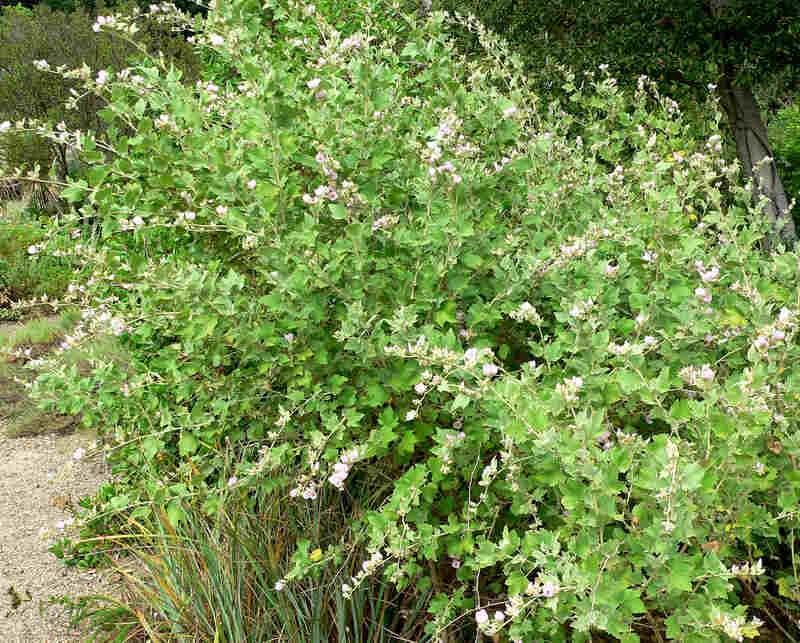
This exemplary species among California’s many native bush mallows produces light pink flowers in elongated clusters during summer. Many cultivars of the chaparral mallow, growing mostly near the coast in Central and Southern California, vary in size and appearance.
Hardiness zones: 8a-11b
Sun: Full sun
Soil: Any well-draining soil
Duration: Evergreen
Height: 3 to 16 feet
Maintenance: Prune in late summer or fall for compact growth.
Coffeeberry (Frangula californica)
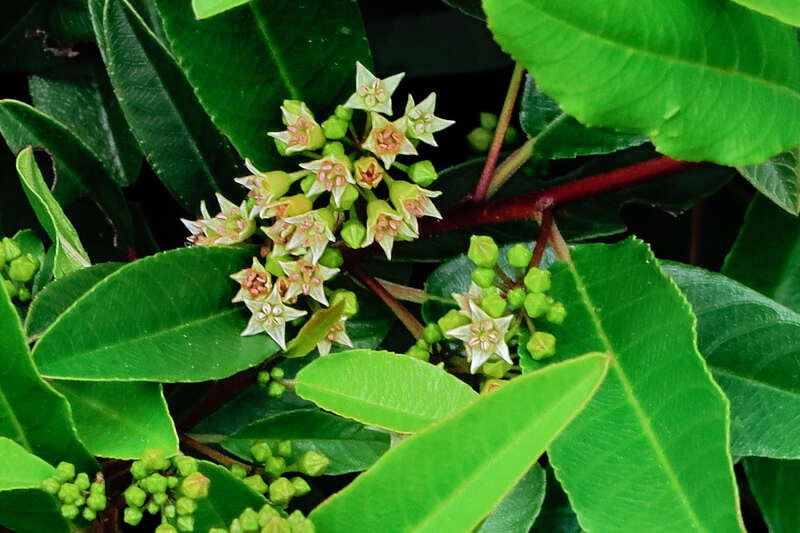
Formerly known by the scientific name Rhamnus californica, this common California shrub has dark green leaves and small cream, white, or greenish flowers that sprout in spring and summer. The plant is fire-resistant, and birds love its fruit, so coffeeberry makes a great addition to any landscape.
Hardiness zones: 7a-9b
Sun: Full sun, partial shade
Soil: Tolerates most soil types
Duration: Evergreen
Height: 6 to 15 feet
Maintenance: Prune as needed to maintain desired shape and height
Deergrass (Muhlenbergia rigens)
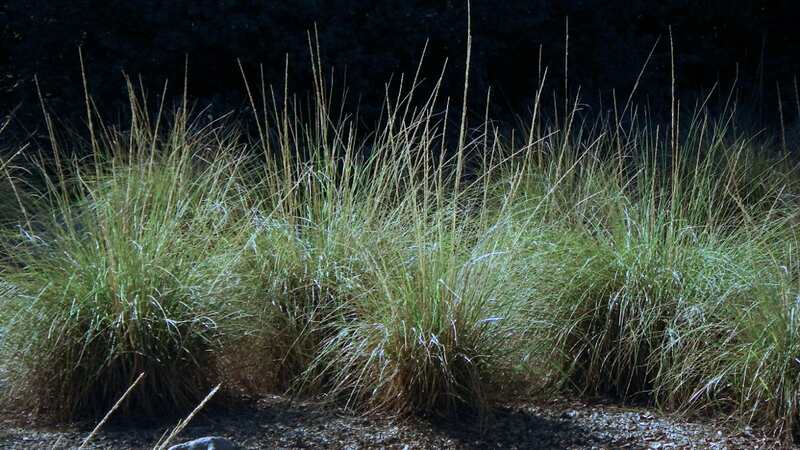
Not technically a shrub, deergrass is a shrub-sized bunchgrass with bright green, silver, or even purple blades. Deergrass is one of the easiest bunchgrasses to grow in California and can reach its mature height of around 5 feet in just one or two years.
Hardiness zones: 7a-10b
Sun: Full sun, partial shade
Soil: Sandy or other well-draining soils
Duration: Evergreen
Height: 3 to 5 feet
Maintenance: Cut back in fall to keep it contained.
Flannel Bush (Fremontodendron californicum)
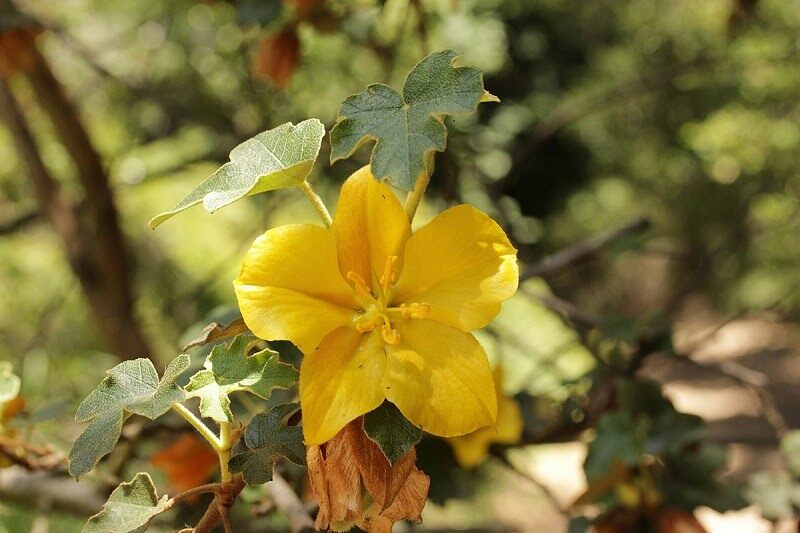
The flannel bush has fuzzy leaves that resemble flannel (that’s where its common name comes from) and large, bright yellow flowers that bloom in spring. The shrub grows quickly and can grow very tall under the right conditions, so it works great as a privacy hedge, but don’t plant it near a high-traffic area, as the leaves can irritate skin.
Hardiness zones: 8a-10b
Sun: Full sun
Soil: Well-draining, sandy soils
Duration: Evergreen
Height: 6 to 20 feet
Maintenance: Avoid summer watering and severe pruning as these can kill the plant.
Giant Wildrye (Leymus condensatus)
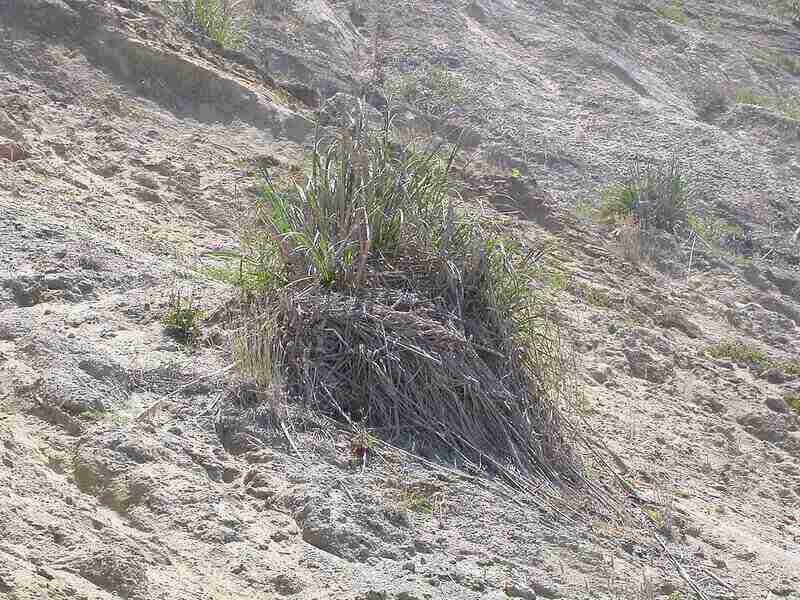
As its common name suggests, giant wildrye is a tall species of wild rye grass that grows in clumps, which can function the same as shrubs in a landscape. “Canyon prince” is a popular cultivar for home planting, but it’s a nursery-bred variety that you won’t find in the wild.
Hardiness zones: 6a-10b
Sun: Full sun
Soil: Tolerates most soil types
Duration: Evergreen
Height: 3 to 6 feet
Maintenance: Prune back to the ground in summer and remove rhizomes to keep it contained as it spreads easily.
Lemonade Berry (Rhus integrifolia)
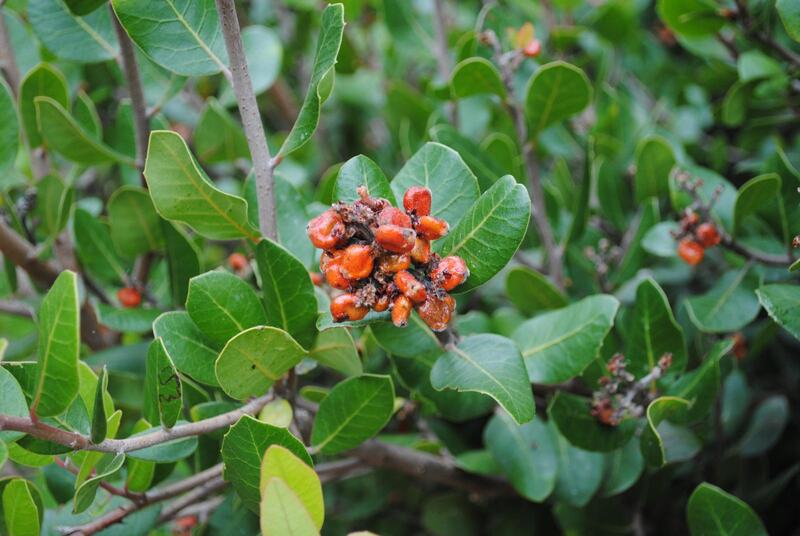
Lemonade berry grows as either a shrub or small tree, with more upright and tree-like growth inland and more low, sprawling growth in coastal areas. Whether you use this plant in your landscaping as a hedge or specimen tree, it will produce small red fruits that are an important food source for local wildlife such as birds and small mammals. Lemonade berry is closely related and grows similarly to another California native plant, sugar bush (Rhus ovata).
Hardiness zones: 9a-11b
Sun: Full sun, partial shade
Soil: Well-draining sandy or loam soils
Duration: Evergreen
Height: 3 to 30 feet depending on location
Maintenance: Prune as needed to maintain desired shape and height.
Manzanita (Arctostaphylos)
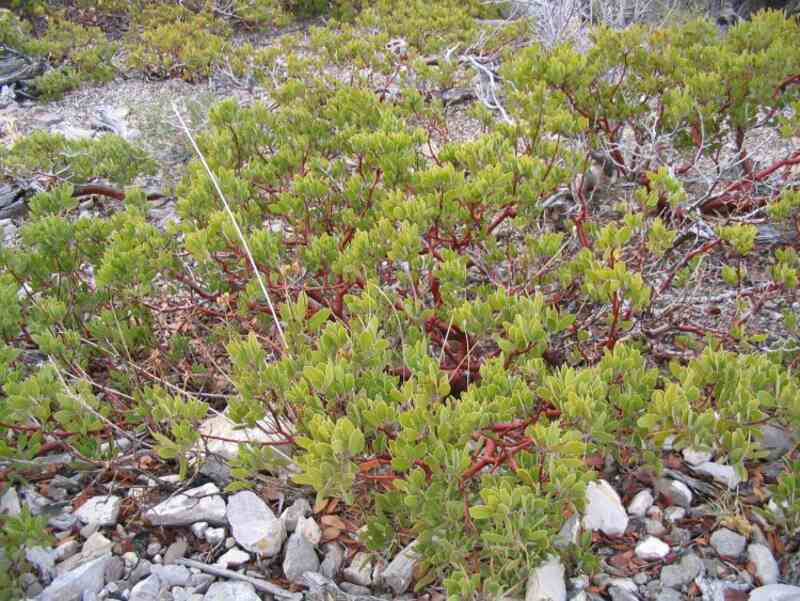
You can find a native manzanita species for your landscape no matter where you live in California, since the many options range from coastal to mountain species. Manzanita shrubs and small trees have interesting red bark on their limbs, bright green leaves, and tiny white or light pink flowers, so they’re a feast of colors.
Hardiness zones: 8a-10b
Sun: Full sun, partial shade
Soil: Well-draining clay, loam, or sandy soils
Duration: Evergreen
Height: 6 to 25-plus feet depending on species and location
Maintenance: Prune in dry summer months, water once a month during summer.
Silver Lupine (Lupinus albifrons)
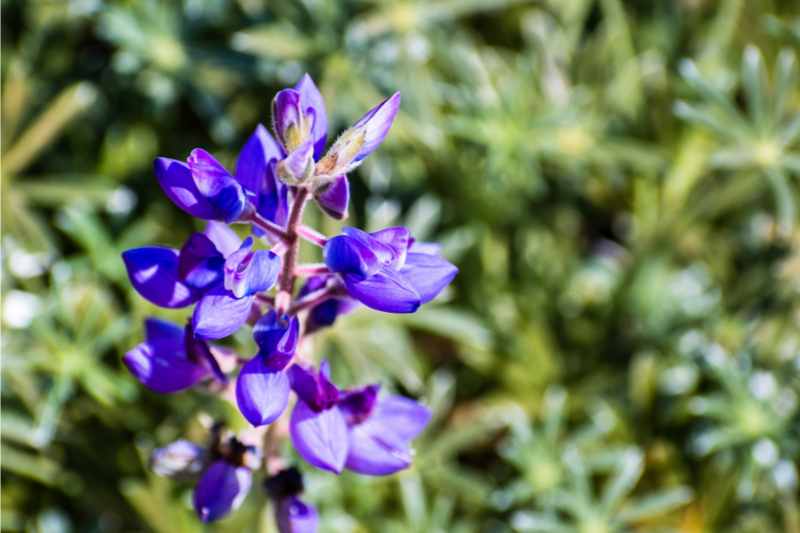
Silver lupine, aka white-leaf bush lupine, aka evergreen lupine, is a mounding, spreading shrub that grows quickly and sprouts upright clusters of pea-shaped blue or purple flowers in winter, spring, and summer that attract pollinators. You’ll see these shrubs all over California, from the coast into the mountains.
Hardiness zones: 6a-10b
Sun: Full sun
Soil: Dry sandy or rocky soils
Duration: Evergreen
Height: 3 to 5 feet
Maintenance: Water once or twice per month in summer.
Toyon (Heteromeles arbutifolia)
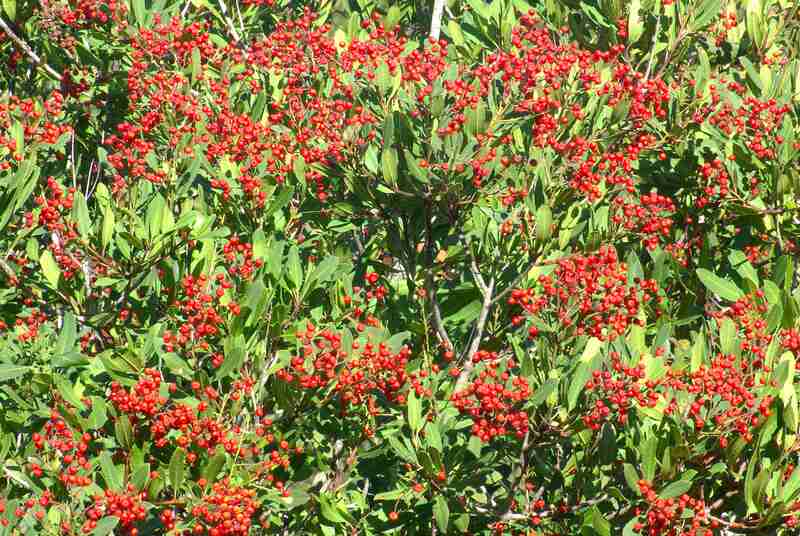
Also known as Christmas berry or California holly for its bright red berries, toyon is native to western parts of California and the Sierra foothills. As a shrub or small tree, it can grow very tall very quickly under proper care, and its white flowers attract butterflies and bees in summer.
Hardiness zones: 7a-11b
Sun: Full sun, partial shade
Soil: Tolerates most soil types
Duration: Evergreen
Height: 6 to 10 feet typically, can reach up to 30 feet
Maintenance: Prune as needed to maintain desired shape and height.
Western Redbud (Cercis occidentalis)
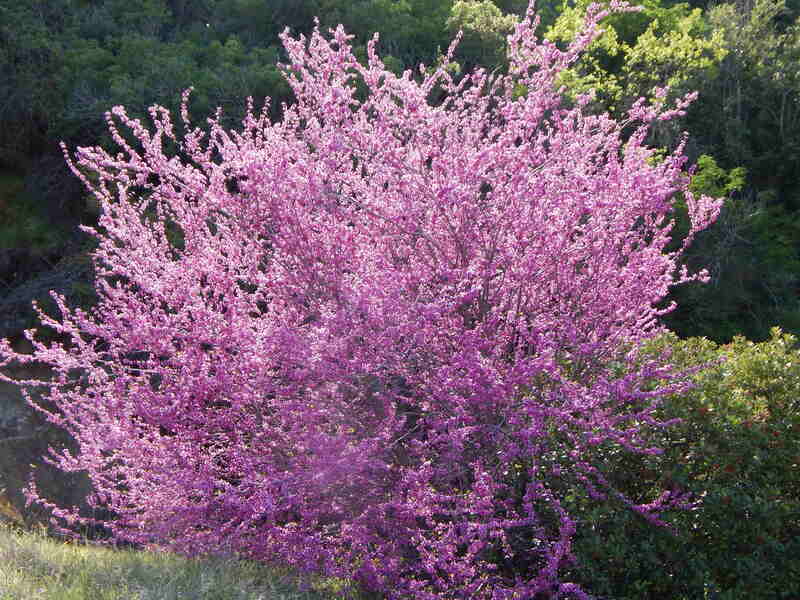
Especially in Northern California where they grow best, you can grow a western redbud as a large shrub or small tree depending on how you prune and train it. Either way, the plant will have light green leaves early in the growing season that turn dark green as they age and sprout clusters of bright pink or magenta flowers in the spring.
Hardiness zones: 7a-9b
Sun: Full sun, partial shade
Soil: Tolerates most soil types
Duration: Deciduous
Height: 10 to 20 feet
Maintenance: Prune as needed to maintain desired shape and height.
For more information about native California plants and why you should consider adding them to your garden, check out the California Native Plant Society (CNPS) native plant database.
FAQ
How Can I Save Money On My Water Bill Using Flowers Native to California?
You can save money and reduce your water usage by creating a xeriscaping garden using the native flora of California. Xeriscaping involves using drought-tolerant plants, so you won’t need to water them as frequently as non-native plants. The best part is that you can save money on your water bill while positively impacting California’s ecosystem!
How Many Native Plants Are In California?
According to the California Department of Fish and Wildlife, “California hosts approximately 6,500 species, subspecies, and varieties of plants that occur naturally in the state, and many of these are found nowhere else in the world.”
Did you know it’s against California law to kill or have rare, threatened, or endangered plant species? But there are some exceptions! The California Department of Fish and Wildlife (CDFW) can give you a permit to kill or have these species for things like science, education, or management reasons.
What Are Some of the Benefits of Using California Natives?
- Don’t require mowing (huge benefit)
- Require fewer pesticides and fertilizers than non-native plants (eco-friendly)
- Use less water than lawns and help prevent erosion (soil stabilizers)
- Reduce flooding and water runoff
- Reduce air pollution (They love our carbon dioxide and create more oxygen.)
- Provide food and shelter for wildlife
- Promote biodiversity
Call In The Pros
So, with all the challenges of being a homeowner in California — extended droughts, wildfires, and extreme heat, choosing drought-tolerant California native plants for landscaping should be a no-brainer! Whether you live in San Diego, Los Angeles, Long Beach, Anaheim, or Riverside, hire a landscaping professional who can bring your landscaping ideas to life.
Main Photo Credit: Alan Schmierer / Flickr / CC0 1.0
